© OHTA, 2012 (last updated February 2012)
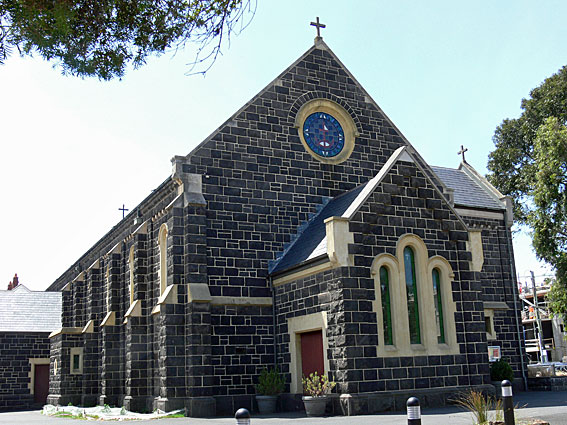
St Joseph's Church, Port Melbourne: the western façade
[photograph by John Maidment (21 February 2012)]
Historical and Technical Documentation by John Maidment
© OHTA, 2012 (last updated February 2012)

St Joseph's Church, Port Melbourne: the western façade
[photograph by John Maidment (21 February 2012)]
The present St Joseph's Church was opened in May 1881. It was designed by architect M. Hennessy in a simplified Romanesque style and constructed in bluestone.1 Small transepts (used as side chapels), sacristies and nuns' choir were added later in the 1920s. The church has always been run by the Carmelite order.2 The building consists of a long nave without aisles and an apse; the Carmelite insignia is painted above the sanctuary arch.
The organ was built by George Fincham although the nameplate has been removed. It dates from before before May 1875 when it was opened at the Wesleyan (Methodist) Church, Coburg and was supplied secondhand.3 It appears to have been built as a residence organ, possibly around 1870 by Fincham, with the name of Henry Kemmis inscribed in pencil inside the swell box.4 An Open Diapason of remnant pipes was later installed, together with a Principal (Dulcet), which Fincham described in 1897 as being of "wretched condition".5
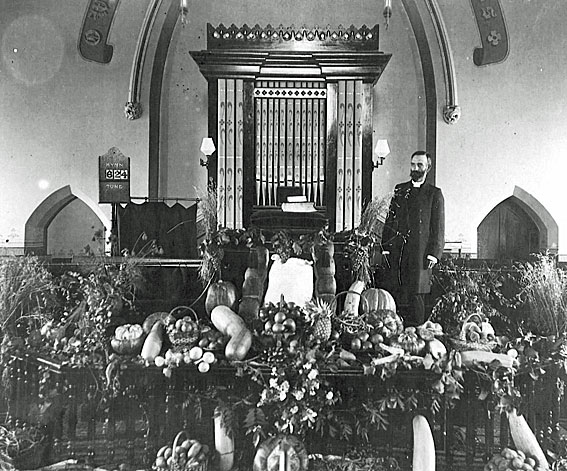
St Joseph's Church, Port Melbourne : the organ when at the Wesleyan Church, Coburg
[courtesy of the Coburg Historical Society (c.2004)]
An illustration of the organ at the Coburg church, during a Harvest Sunday celebration, was found in the archives of the Coburg Historical Society.6 In 1924, the Coburg church acquired a two-manual organ from J.E. Dodd, of Adelaide, displacing the Fincham organ, which appears to have gone to St Joseph's, Port Melbourne shortly afterwards. The Pedal Bourdon appears to have been placed on tubular-pneumatic action at this time and its compass extended. An electric blower may also have been introduced.7
In 1977, the double-rise reservoir was releathered by George Stephens but unfortunately the feeders were removed, owing to cost.8 The pipework was later restored by Australian Pipe Organs Pty Ltd, with recycled spotted metal treble pipes by Fincham replacing the disparate pipes of the Open Diapason. A former Gamba was renamed Vox Angelica at this time and made to undulate with the Dulciana; it is possible that this is a recycled Fincham stop as the holes in the rackboard are oversize for this rank. The façade pipes had been lightly stencilled in green and gold paint and this was removed in 1977 to reveal the very fine spotted metal beneath. Fretwork that surmounted the case was also dismantled and stored in the organ gallery.
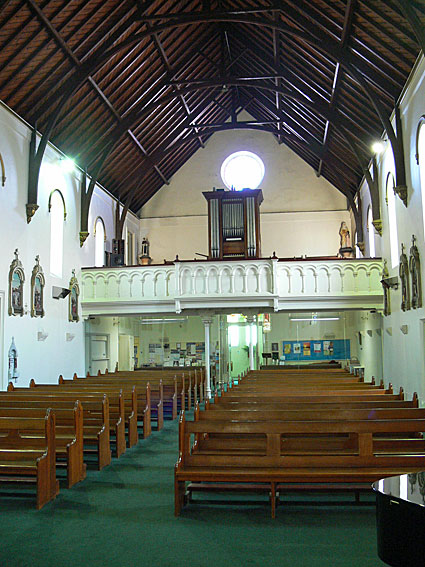
St Joseph's Church, Port Melbourne : the organ from the sanctuary steps
[photograph by John Maidment (21 February 2012)]
This was one of the largest single-manual organs built by Fincham in the period 1865-1875. Its origins as a chamber organ are confirmed by the provision of a full-length Dulciana 8ft in the façade (a feature also shared with the lost organ built in 1873 by Fincham for Edward A'Beckett, Brighton), and the fine blackwood casework with oversized cornice. The provision of a Dulcet 4ft and Piccolo 2ft rather than the more usual Principal and Fifteenth, and enclosure of most of its ranks in a swell box, also reflect its origins in a residence.

St Joseph's Church, Port Melbourne : the organ from side of the gallery
[photograph by John Maidment (21 February 2012)]
| MANUAL Open Diapason Stopd Diap Bass Clarabella Dulciana Vox Angelica Dulcet Flute Piccolo Pedal Coupler PEDAL Bourdon |
8ft 8ft 8ft 8ft 8ft 4ft 4ft 2ft 16 |
gvd.bass non-original, treble using Fincham pipes from elsewhere inserted c.1980 CC-BB TC full compass TC was Gamba 8ft before c.1980 open wood open wood, metal top octave |
Compass: 56/29
Mechanical manual and stop action; tubular-pneumatic pedal action
Trigger swell lever
Composition pedals may have been removed
6ft wide; 4ft 7 in deep plus 8 in for Bourdon, 10ft 5 ½ in high9
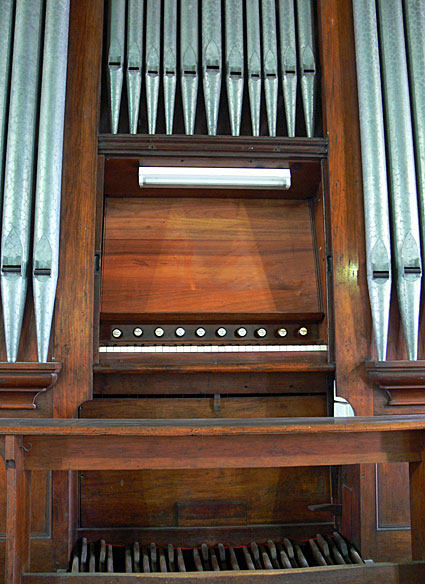
St Joseph's Church, Port Melbourne : console
[photograph by John Maidment (21 February 2012)]
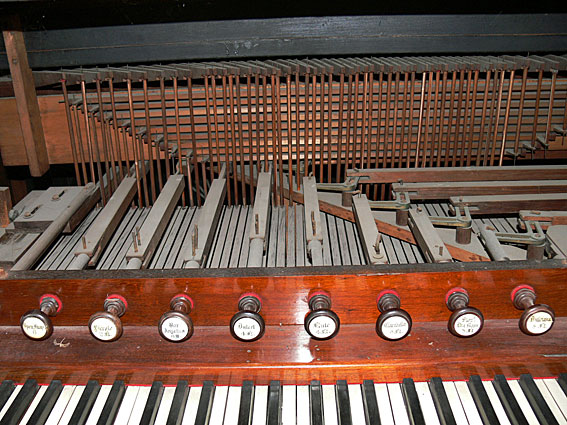
St Joseph's Church, Port Melbourne : console detail showing drawstops and key action
[photograph by John Maidment (21 February 2012)]

St Joseph's Church, Port Melbourne : internal pipework
[photograph by John Maidment (21 February 2012)]
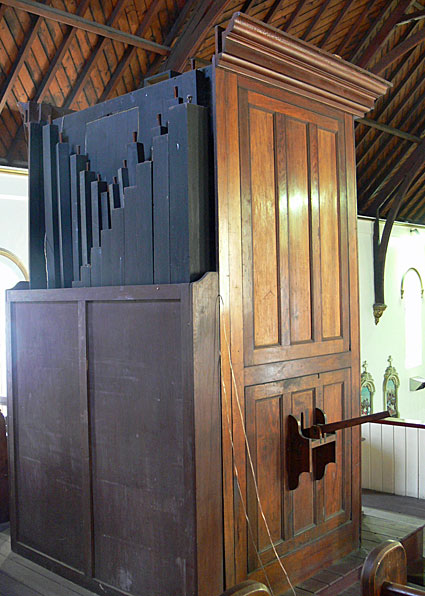
St Joseph's Church, Port Melbourne : view from rear showing Bourdon
[photograph by John Maidment (21 February 2012)]
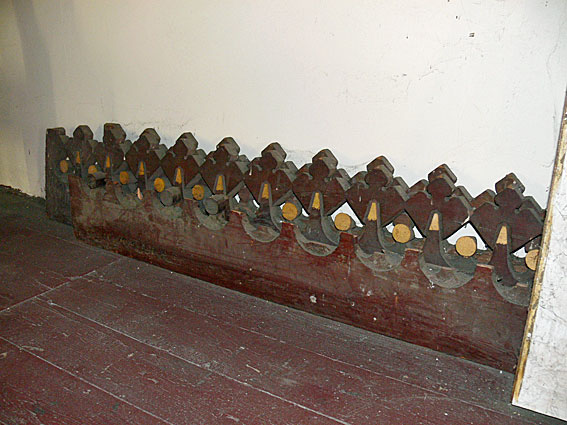
St Joseph's Church, Port Melbourne : casework cresting in storage in gallery
[photograph by John Maidment (21 February 2012)]
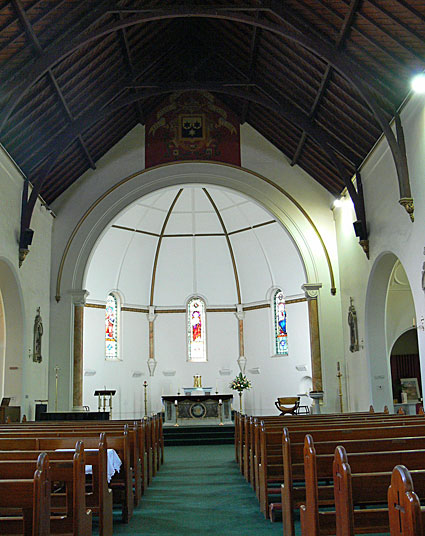
St Joseph's Church, Port Melbourne : view of church interior looking towards sanctuary
[photograph by John Maidment (21 February 2012)]
1 Advocate 7 & 14 May 1881
2 Some of the Fruits of Fifty Years: Ecclesiastical Annals (Melbourne: Massina, 1897), p. 52
3 E.N. Matthews, Colonial Organs and Organbuilders (Carlton: Melbourne University Press, 1969), p.127
4 Noted by John Maidment 1977
5 Matthews, op cit, p.127
6 Discovered by John Maidment c.2004, courtesy of Lawrie Shears
7 Noted by John Maidment 1977
8 Ibid.
9 Revised notes by John Maidment 21 February 2012